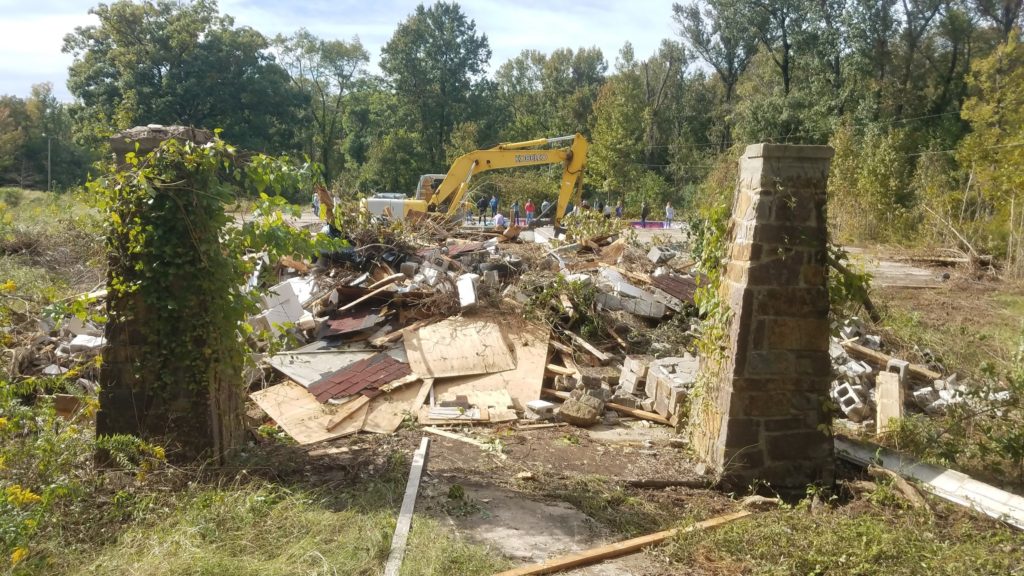By Acadia Roher
Hey everyone! Acadia again. For my previous post on the West Rock community, click HERE.
The end of West Rock was the beginning of a new story at a place clear across town called Granite Mountain. Last fall, I tagged along with a field trip from the University of Central Arkansas to better orient myself to the Granite Mountain area, which was once home to Gillam Park and Booker Homes, an ill-fated public housing project designed for Little Rock’s Black residents.
Booker Homes was torn down in the 1990s, but senior housing and a new subdivision have sprung up since then. The Little Rock Audubon Center has also developed hiking trails and other infrastructure on this site. The Gillam Park pool was in the process of being filled in on our visit and other structures had long since been demolished. It was eerie out there, knowing that soon there will be almost no physical representation of a place that has centered in the experience of so many of Little Rock’s Black residents.


Once a sleepy crossroads several miles southeast of the downtown area and across Fourche Creek, Granite Mountain was cleared of 165 homes and other structures in the early 1950s to make way for thousands of new residents virtually overnight. Booker Homes, a 400-unit public housing complex and the new Granite Heights subdivision were meant to house Black residents displaced by slum clearance projects. Pilgrim’s Rest church relocated to Granite Mountain from West Rock to begin its next chapter. Booker High School was built to serve the sudden influx of students.

City leaders had first shown interest in the area decades before when land was needed to house people made homeless during the Great Depression. The city purchased a large tract of land in 1934 that became the center of a push by Black community leaders for a public park. At the time, six public parks in Little Rock were maintained for white residents while Black residents were forced to rely on generous private landowners for outdoor recreation. The city dragged its heels for years, building and dismantling park infrastructure, abandoning then restarting the project at what became known as Gillam Park. Finally, in 1949, a growing Black political force pressured the city to hold an election for a bond issue to fully fund Gillam Park.
To everyone’s surprise, voters approved the bond issue. While the park was finally built out, other massive changes in Granite Mountain and the city as a whole were underway. City leaders used the funds as leverage to secure millions of dollars of federal funding for their slum clearance and urban renewal plans. The picture below shows the extent of the racial redistricting that occurred just in the decade between 1954 and 1964. The sharp decrease in mixed-race orange and yellow shaded areas of the map is visual evidence of the increasing segregation of the city.

The pool at Gillam Park opened to great fanfare just one year before the first residents began moving in at Booker Homes. But as with most amenities in this far eastern corner, city officials allocated too few resources for its upkeep. The most immediately tragic result was the drowning of 12-year-old Tommy Grigsby in 1954. Understaffed, underequipped, and far away from emergency services, Gillam Park had become a death trap. L.C. and Daisy Bates’ newspaper, the State Press, said of the incident, “the whole affair was a study in second class citizenship.”
Booker Homes, too, became hazardous due to limited resources and neglect. In 1998, an article in the New York Times reported on the HOPE VI program, begun under President Bill Clinton: “On a scale not seen in decades, the Federal Government is helping cities clear slums again, but this time they are slums it helped create: public housing projects crippled by flawed policies and mismanagement and overwhelmed by poverty and crime.” Little Rock housing officials began applying for HOPE VI funds in 1996 and were awarded over $1.5 million in 2000 to demolish Booker Homes. Most Granite Mountain residents displaced during this round of housing demolition were likely given vouchers to find housing in the private sector. HOPE VI led to a shortage of affordable and accessible low income housing that Little Rock and other cities are still facing today.
For more information:
Community Profile: Granite Mountain. Common Ground Education Initiative. Audubon Arkansas. 2006.
Earl Saunders, Jr., photographs, UALR.PH.0106. UA Little Rock Center for Arkansas History and Culture. https://arstudies.contentdm.oclc.org/digital/collection/findingaids/id/9300/rec/2
“Granite Heights Subdivision Marks ‘First’ for Little Rock Negroes” Arkansas Democrat, January 6, 1957.
Granite Mountain Neighborhood Community Improvement Work Plan. Granite Mountain Neighborhood Improvement Association. 2011.
Kirk, John A. “A Study in Second-Class Citizenship: Race, Urban Development, and Little Rock’s Gillam Park, 1934-2004.” Arkansas Historical Quarterly 64 (Autumn 2005).
Johnson, Ben F., III. Arkansas in Modern America, 1930–1999. Fayetteville: University of Arkansas Press, 2000.
“Plan for the homeless echoes Gillam Park history” Arkansas Times, July 20, 2017. https://www.arktimes.com/arkansas/plan-for-the-homeless-echoes-gillam-park-history/Content?oid=8133527
“Razing the Slums to Rescue the Residents” The New York Times, September 6, 1998.